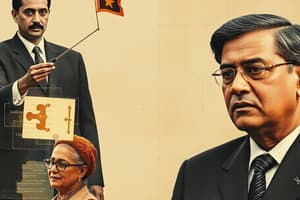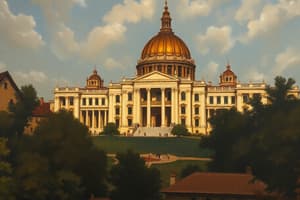Podcast
Questions and Answers
What is a key responsibility of the President when no party has a clear majority?
What is a key responsibility of the President when no party has a clear majority?
- Draft new laws for the country
- Dismiss the Lok Sabha
- Choose and appoint the Prime Minister (correct)
- Appoint the Vice President
What is the term length for the Vice President of India?
What is the term length for the Vice President of India?
- Five years (correct)
- Four years
- Seven years
- Six years
What is the primary role of the president in a parliamentary system?
What is the primary role of the president in a parliamentary system?
- To control the executive branch directly
- To represent the government in legislative matters
- To exercise significant day-to-day powers
- To serve as the ceremonial head of state (correct)
What distinguishes a semi-presidential system from a parliamentary system?
What distinguishes a semi-presidential system from a parliamentary system?
In what scenario can the Vice President take over the President's office?
In what scenario can the Vice President take over the President's office?
How can the Vice President of India be removed from office?
How can the Vice President of India be removed from office?
What requirement must be met for the Speaker to report a matter to the Supreme Court in Sri Lanka?
What requirement must be met for the Speaker to report a matter to the Supreme Court in Sri Lanka?
What role does the Vice President hold in the Rajya Sabha?
What role does the Vice President hold in the Rajya Sabha?
How does the impeachment process differ between Sri Lanka and India?
How does the impeachment process differ between Sri Lanka and India?
What is the intended purpose of the parliamentary executive in India as per the Constitution?
What is the intended purpose of the parliamentary executive in India as per the Constitution?
What action might a President take if they disagree with the Prime Minister's request to impose President’s rule?
What action might a President take if they disagree with the Prime Minister's request to impose President’s rule?
In a semi-presidential system, what can occur regarding the political affiliations of the President and Prime Minister?
In a semi-presidential system, what can occur regarding the political affiliations of the President and Prime Minister?
Which of the following is NOT a reason for the Vice President to act as President?
Which of the following is NOT a reason for the Vice President to act as President?
What does the President's role in appointing a Prime Minister entail when there is a coalition government?
What does the President's role in appointing a Prime Minister entail when there is a coalition government?
What major experience influenced the formation of the Indian parliamentary system?
What major experience influenced the formation of the Indian parliamentary system?
What is a key feature of countries with a parliamentary executive?
What is a key feature of countries with a parliamentary executive?
What is one of the main responsibilities of ministers in a democracy?
What is one of the main responsibilities of ministers in a democracy?
How does the Constitution of India ensure representation in the bureaucracy for weaker sections of society?
How does the Constitution of India ensure representation in the bureaucracy for weaker sections of society?
What does it mean for the bureaucracy to be politically neutral?
What does it mean for the bureaucracy to be politically neutral?
What role does the Union Public Service Commission play in the Indian bureaucracy?
What role does the Union Public Service Commission play in the Indian bureaucracy?
What is expected of administrative officers in relation to policies adopted by the legislature?
What is expected of administrative officers in relation to policies adopted by the legislature?
What happens to members of the Public Service Commissions regarding their term and removal?
What happens to members of the Public Service Commissions regarding their term and removal?
What is the primary reason for the complexity of the Indian bureaucracy?
What is the primary reason for the complexity of the Indian bureaucracy?
In the context of a new government opting for different policies, what is the responsibility of the administrative machinery?
In the context of a new government opting for different policies, what is the responsibility of the administrative machinery?
What is a constitutional obligation of the Prime Minister regarding the Council of Ministers?
What is a constitutional obligation of the Prime Minister regarding the Council of Ministers?
What factor does NOT contribute to the power of the Prime Minister?
What factor does NOT contribute to the power of the Prime Minister?
How has the coalition nature of Indian politics affected the power of the Prime Minister?
How has the coalition nature of Indian politics affected the power of the Prime Minister?
What has been a common consequence of coalition governments since 1989 in India?
What has been a common consequence of coalition governments since 1989 in India?
What is a key factor affecting the power wielded by the Prime Minister?
What is a key factor affecting the power wielded by the Prime Minister?
Which of the following is NOT cited as a source of the Prime Minister's power?
Which of the following is NOT cited as a source of the Prime Minister's power?
What has been a characteristic of Indian politics since the rise of coalition governments?
What has been a characteristic of Indian politics since the rise of coalition governments?
What can be inferred about the stability of coalition governments in India?
What can be inferred about the stability of coalition governments in India?
What is the primary role of IAS and IPS officers within the governmental structure?
What is the primary role of IAS and IPS officers within the governmental structure?
How are IAS and IPS officers appointed?
How are IAS and IPS officers appointed?
What aspect of the bureaucracy contributes to a citizen's fear of approaching government officers?
What aspect of the bureaucracy contributes to a citizen's fear of approaching government officers?
Which provision aims to make the bureaucracy more representative?
Which provision aims to make the bureaucracy more representative?
Who has the authority to take disciplinary action against IAS and IPS officers?
Who has the authority to take disciplinary action against IAS and IPS officers?
What is a significant concern regarding the control of bureaucracy by democratically elected governments?
What is a significant concern regarding the control of bureaucracy by democratically elected governments?
What characterizes the role of the district collector?
What characterizes the role of the district collector?
What is the primary function of the bureaucracy as mentioned in the content?
What is the primary function of the bureaucracy as mentioned in the content?
Flashcards are hidden until you start studying
Study Notes
Sri Lankan and Indian President and Prime Minister
- Sri Lanka has a semi-presidential system while India has a parliamentary system.
- In a semi-presidential system, there are both a President and a Prime Minister, unlike the parliamentary system where the President has primarily ceremonial duties.
- In Sri Lanka, the President can possess significant day-to-day powers, while the Prime Minister is the head of government.
- India's President holds a position of authority during periods of instability, while Sri Lanka's President has greater power.
Impeachment of the President in India and Sri Lanka
- In India, the President can be impeached with a resolution passed by both the Lok Sabha (House of the People) and Rajya Sabha (Council of States), with a majority vote.
- In Sri Lanka, if a significant number of parliament members file a claim against the President, and the Speaker verifies the claim, they can report the matter to the Supreme Court.
- The power of the Supreme Court in Sri Lanka is significant in the impeachment process, unlike in India where it is the Parliament that handles impeachment.
Parliamentary System in various Countries
- The parliamentary system is used in many countries, including Germany, Italy, Japan, the United Kingdom, and Portugal.
- This system often has a President or Monarch acting as the head of state, with primarily ceremonial duties.
- In a parliamentary system, the Prime Minister, alongside the cabinet, holds the real power.
Powers of the Indian Prime Minister
- The Indian Prime Minister is elected from the Lok Sabha, the Lower House of Parliament.
- The PM is ultimately responsible for the government’s decisions and policies.
- The Prime Minister is responsible for communicating decisions of the Council of Ministers to the President.
- The Prime Minister is involved in critical decisions regarding the nation’s administration and legislation.
Coalition Governments in India
- Since 1989, India has seen numerous coalition governments where no single party holds a majority in the Lower House.
- These coalitions have led to greater presidential influence in selecting Prime Ministers.
- Coalition governments require more consultation among political partners, potentially weakening the Prime Minister's authority.
- The increased role of the President can further weaken the authority of the Prime Minister.
Indian Bureaucracy
- The Indian bureaucracy operates under the control of the Indian government.
- The government is responsible for supervising and controlling administrative officers in the states.
- The civil service recruitment process is designed to be non-partisan and meritocratic.
- The Union Public Service Commission oversees the recruitment of civil servants.
- The bureaucracy is designed to be neutral, meaning it should not favor any political stance.
- Reservations for Scheduled Castes, Scheduled Tribes, women, Other Backward Classes (OBC), and Economically Weaker Sections (EWS) help to ensure a diverse and inclusive bureaucracy.
- State Public Service Commissions handle the appointment of most state officers.
- IAS (Indian Administrative Service) and IPS (Indian Police Service) officers appointed by the UPSC form the backbone of the higher bureaucracy in the states.
- The bureaucracy is responsible for implementing government policies and welfare programs.
How the Indian Bureaucracy is Politically Accountable
- The Indian government is responsible for supervising the bureaucracy.
- The bureaucracy is expected to be politically neutral.
- The bureaucracy should efficiently implement the policies of the elected government.
- The government is expected to control the bureaucracy to ensure the well-being of the citizens.
Studying That Suits You
Use AI to generate personalized quizzes and flashcards to suit your learning preferences.




